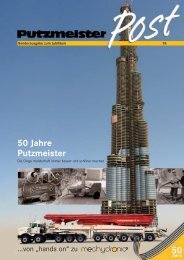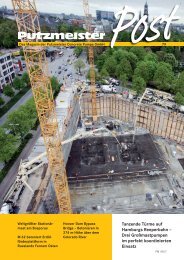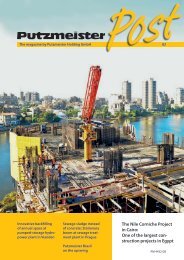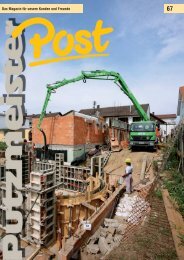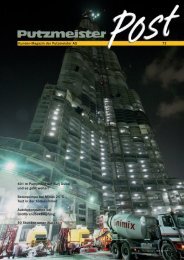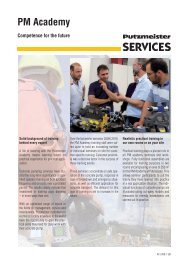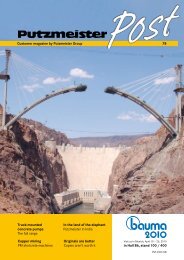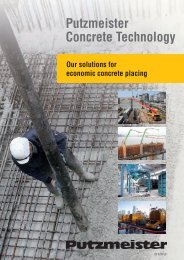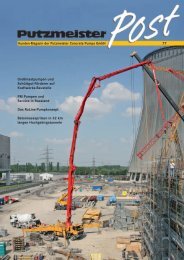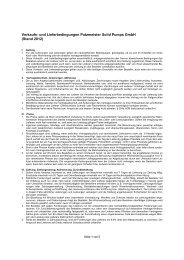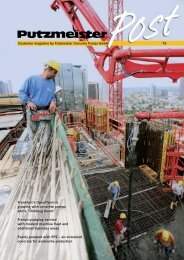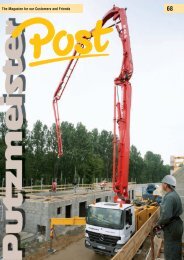The 4h pumping of Neufahrn: Large boom team places ... - Putzmeister
The 4h pumping of Neufahrn: Large boom team places ... - Putzmeister
The 4h pumping of Neufahrn: Large boom team places ... - Putzmeister
Create successful ePaper yourself
Turn your PDF publications into a flip-book with our unique Google optimized e-Paper software.
On site<br />
Telebelt conveys enormous masses<br />
<strong>of</strong> concrete at the third-largest<br />
embankment dam in the world<br />
At the Jinsha River – a tributary <strong>of</strong> the<br />
Yangtze – the Xiluodu hydro-electric<br />
plant is currently being built. Its main<br />
purpose is to generate electricity but it<br />
also fulfi ls other tasks: fl ood protection,<br />
deposition <strong>of</strong> sediment, improvement <strong>of</strong><br />
shipping conditions, etc. It is expected<br />
to produce from 57 to 64 billion kilowatt<br />
hours <strong>of</strong> electrical energy each year,<br />
making this plant the third largest hydroelectric<br />
plant in the world.<br />
A double-curved arch dam should dam up a<br />
storage lake <strong>of</strong> 12.67 billion m 3 . <strong>The</strong> absolute<br />
elevation <strong>of</strong> the dam crest is 610 m, the maximum<br />
height <strong>of</strong> the dam is 278 m and the<br />
overall length is 700 m. <strong>The</strong> total excavated<br />
material for this project amounts to 39.81<br />
million m 3 <strong>of</strong> which 25.61 million m 3 is above-ground<br />
excavation and 14.20 million m 3 is<br />
from the construction <strong>of</strong> tunnels.<br />
In total, 16.72 million m 3 <strong>of</strong> concrete is required<br />
for this project and 6.60 million m 3 <strong>of</strong><br />
this is required just for the body <strong>of</strong> the wall.<br />
<strong>The</strong> concreting work commenced in 2008. It<br />
is expected that the fi rst generator sets can be<br />
installed in June 2012. From June 2013, the<br />
fi rst electrical energy should be generated<br />
and the entire project should be completed<br />
by 2015. US$ 7.36 billion has been invested<br />
in the Xiluodu hydro-electric plant.<br />
<strong>The</strong> devices in the Xiluodu dam that are<br />
planned for fl ood water fl ow include seven<br />
overfl ow drainage openings at a size <strong>of</strong> 12.5 m<br />
x 13.5 m, below them eight outlets at a size<br />
<strong>of</strong> 6 m x 6.7 m and four exceptionally large<br />
overfl ow tunnels (with a diameter <strong>of</strong> up to<br />
15 m) – two tunnels on the right embankment<br />
and two more on the left. <strong>The</strong> overfl ow<br />
capacity <strong>of</strong> the project amounts to up to<br />
49,923 m 3 /s. <strong>The</strong> power that is generated by<br />
the overfl ows is almost 100 million kilowatts<br />
and is therefore the highest in the world. <strong>The</strong><br />
four overfl ow tunnels are the largest <strong>of</strong> their<br />
kind in the world and have a discharge rate<br />
<strong>of</strong> 16,000 m 3 /s, which is about a third <strong>of</strong> the<br />
entire outlet capacity <strong>of</strong> the plant.<br />
<strong>The</strong> water quantity and fl ow rate place<br />
high demands on the concrete<br />
<strong>The</strong>se numbers are not just attributed to the<br />
size <strong>of</strong> the tunnel but also to the fl ow rate<br />
<strong>of</strong> the river, which is amongst the fastest in<br />
the world (up to 50 m/s). Since these four<br />
overfl ow tunnels were designed to cope with<br />
exceptionally large quantities <strong>of</strong> water at an<br />
extremely high fl ow rate, the concrete that is<br />
used here must be <strong>of</strong> outstanding quality. <strong>The</strong><br />
difference between this concrete and a pumpable<br />
concrete mix lies mainly in the proportions<br />
<strong>of</strong> the individual concrete raw materials<br />
23<br />
‚ <strong>The</strong> longest river in Asia<br />
with the changing name<br />
<strong>The</strong> 6,300 km long Chang Jiang (also<br />
known as the Yangtze - the “Long River”) is<br />
the longest river in Asia and, after the Nile<br />
and the Amazon, is the third-longest river<br />
in the world. It originates as the Dri Chu<br />
(Tibetan “river <strong>of</strong> the female yak”) from the<br />
Ganjajubu glacier at an altitude <strong>of</strong> 5,405 m<br />
and continues under the name <strong>of</strong> Jinsha<br />
Jiang – “Gold Sands River” – from north<br />
to south along the entire border between<br />
Sichuan and Tibet. In the Hengduan Mountains,<br />
it crosses the border between Sichuan<br />
and Yunnan. From the city <strong>of</strong> Shuifu, it<br />
fl ows under the name <strong>of</strong> Yangtze until it<br />
reaches the East China Sea to the north <strong>of</strong><br />
Shanghai.<br />
‚ <strong>The</strong> dam should reduce<br />
sludge load<br />
In the Red Basin, the Yangtze is fed by numerous<br />
tributaries that drain, for example,<br />
the eastern slopes <strong>of</strong> the Tibetan highlands.<br />
T I B E T A N P L A T E A U<br />
14 PM 4356 GB PM 4356 GB 15<br />
TIBET<br />
that are used. Pumpable concrete requires a<br />
relatively high fl owability so that it can fl ow<br />
through the delivery line. This means that<br />
concrete raw materials such as cement and<br />
fl y ash are required in large quantities. However,<br />
cement creates a lot <strong>of</strong> hydration heat<br />
when setting the concrete, meaning that the<br />
temperature and crack formation are diffi cult<br />
to control. <strong>The</strong> dissipation <strong>of</strong> the hydration<br />
heat may pose a problem, particularly with<br />
structures such as a dam.<br />
25<br />
Mekong<br />
<strong>The</strong> tributaries feed the Yangtze with large<br />
quantities <strong>of</strong> sand, silt and clay – an annual<br />
quantity <strong>of</strong> approximately 680 million tons,<br />
which is as much as the Nile, the Mississippi<br />
and the Amazon together! This makes the<br />
“Long River” one <strong>of</strong> the most sediment-rich<br />
rivers in the world. Where it is damed – like<br />
at the huge Three Gorges Dam – the fl ow<br />
velocity <strong>of</strong> the water slowes down, sediment<br />
is stored in the reservoir and gradually silts<br />
up. <strong>The</strong> Xiluodu dam should counteract this.<br />
It is expected that the dam should reduce<br />
the quantity <strong>of</strong> sludge in the Yangtze by a<br />
third.<br />
‚ Mammoth producers<br />
<strong>of</strong> energy<br />
Once completed, the Xiluodu hydro-electric<br />
plant will produce 12,600 MW <strong>of</strong> power.<br />
This means that, with regard to power<br />
plant capacity, it would be the secondlargest<br />
hydro-electric plant in China after<br />
the Three Gorges project and the third-largest<br />
in the world. <strong>The</strong> China Yangtze Three<br />
Gorges Project Development Corp. is plan-<br />
Jinsha Jiang<br />
YUNNAN<br />
SICHUAN<br />
Xiluodu<br />
Dam<br />
Telebelt comes out ahead<br />
Telebelt is a mobile belt conveyor that can<br />
continuously convey any kind <strong>of</strong> bulk materials<br />
and concrete and is unrestricted by the<br />
pumpability <strong>of</strong> the concrete. Telebelt is therefore<br />
the perfect solution for pouring highquality<br />
mass concrete as it not only means<br />
that fewer cracks are formed but it also reduces<br />
the costs for the concrete.<br />
Yangtze<br />
On site<br />
ning three more giant hydro-electric plants<br />
at the overfl ow <strong>of</strong> the Yangtze, namely Wudongde,<br />
Baihetan and Xiangjiaba. At 38.5<br />
million kWh each year, their combined<br />
power generation should be double that <strong>of</strong><br />
the Three Gorges Project.<br />
‚ Special confi guration:<br />
Arch dam<br />
In valleys that are very high and narrow,<br />
the preferred dam to build is the arch dam.<br />
<strong>The</strong> wall forms a vertically and horizontally<br />
tensioned arch towards the side <strong>of</strong> the<br />
water. Due to the arch-shaped design that<br />
is directed against the fl ow <strong>of</strong> the river, the<br />
mass <strong>of</strong> water is distributed over a larger<br />
surface area and therefore puts less stress<br />
on each unit <strong>of</strong> area. Signifi cantly fewer<br />
materials are required to construct these<br />
dams than are required for other types <strong>of</strong><br />
dams. However, the water pressure is diverted<br />
over the arch to the foundations in<br />
the mountain at the side. <strong>The</strong> attachment<br />
to the rock is therefore particularly important<br />
with this wall design.<br />
Three Gorges<br />
Dam<br />
C h i n a<br />
<strong>The</strong> fi rst Telebelt TB 105 delivered by<br />
<strong>Putzmeister</strong> has been used in the Three<br />
Gorges Dam project since the year 2000. To<br />
date, the number <strong>of</strong> operating hours amounts<br />
to more than 20,000 hours and the device<br />
continues to work properly – clear pro<strong>of</strong> <strong>of</strong><br />
the robustness and reliability <strong>of</strong> the Telebelt.<br />
Due to this experience, the company responsible<br />
for the Three Gorges project ordered<br />
two more Telebelts <strong>of</strong> the new type TB 110G<br />
for the <strong>team</strong> from SinoHydro Bureau 7. Since<br />
24



